For many men facing a prostate cancer diagnosis, the biggest challenge isn’t just the disease, it’s choosing the right treatment. Traditional options like surgery and radiation can be effective but come with risks to urinary and sexual function. That’s why an increasing number of patients are turning to HIFU (High-Intensity Focused Ultrasound) , a treatment that offers targeted therapy with fewer side effects.
HIFU represents a safer and smarter path forward for select patients with localized prostate cancer. By delivering intense, focused ultrasound energy to destroy cancer cells without incisions or radiation, HIFU combines precision with preservation offering a real alternative for men who want to protect their quality of life.
In this article, we’ll explore what makes HIFU an intelligent option for prostate cancer, who it’s best suited for, how it works, and where it fits into the modern landscape of cancer care.
What Is HIFU?
HIFU stands for High-Intensity Focused Ultrasound, a minimally invasive, image-guided treatment designed to destroy targeted areas of prostate tissue using sound waves. The procedure is performed using a probe inserted into the rectum. This probe emits ultrasound waves that converge at a focal point inside the prostate, heating the tissue to a temperature high enough (typically 80–100°C) to ablate cancer cells.
Unlike radiation or surgery, HIFU avoids damage to surrounding healthy tissue, reducing the risk of serious complications. The treatment is often performed on an outpatient basis, meaning no overnight hospital stay is needed.
Why HIFU Is a Safer Future for Many Men
The appeal of HIFU lies in its ability to target only the cancer, rather than treating the entire prostate. This approach, known as focal therapy, is a significant advancement in how prostate cancer is managed. It’s part of a broader shift in oncology toward personalized, precision medicine.
Here’s why HIFU is increasingly seen as a smart and safer choice:
- Minimally Invasive: No surgical incisions or stitches are required.
- Lower Risk of Incontinence: HIFU avoids damage to urinary sphincters, helping preserve bladder control.
- Better Sexual Function Outcomes: Erectile nerves are more likely to remain intact compared to radical prostatectomy.
- Shorter Recovery Time: Most patients return to daily activities within a few days.
- Repeatable Treatment: HIFU can be performed more than once, unlike some other therapies.
These benefits are especially meaningful for men who prioritize their independence, physical comfort, and sexual health. It’s not just about curing cancer, it’s about how you live afterward.
Who Is an Ideal Candidate for HIFU?
HIFU is not for everyone. It is best suited for men who:
- Have localized prostate cancer (confined to the prostate gland)
- Are in early to intermediate stages (typically Gleason score 6 or 7)
- Want to avoid or delay major surgery or radiation
- Have a life expectancy of 10+ years
- Are otherwise healthy and able to undergo anesthesia
HIFU may also be considered as a salvage therapy used after radiation or surgery has failed and cancer has returned in a small, localized area.
However, HIFU is not typically recommended for men with:
- Aggressive or fast-growing cancer (Gleason 8–10)
- Cancer that has spread beyond the prostate
- Extensive calcification inside the prostate (which may block sound waves)
A detailed evaluation with a urologist including MRI, PSA testing, and biopsy results is essential before determining candidacy.
How the Procedure Works
The HIFU procedure usually lasts between 1.5 to 3 hours, depending on the size and location of the targeted area. Patients are under spinal or general anesthesia and do not feel pain during the procedure.
Here’s what a typical HIFU journey looks like:
- Pre-Procedure Assessment: Imaging (usually MRI) and a biopsy are used to map the prostate and identify cancer zones.
- Treatment Planning: Physicians use real-time ultrasound or MRI to guide the probe and define the treatment area.
- Ablation: The probe emits ultrasound waves that converge at a precise focal point inside the prostate to heat and destroy cancer cells.
- Recovery: Most men return home the same day. Some may require a temporary catheter for 1–2 weeks.
No external radiation. No surgical incision. No hospital stay. It’s a leap forward in urologic oncology.
What Are the Results?
Numerous studies have shown that HIFU can offer excellent cancer control for men with localized prostate cancer, especially when paired with accurate diagnosis and imaging.
- Success rates for focal HIFU in low- to intermediate-risk prostate cancer range from 80% to 95% over a 5-year follow-up.
- Urinary incontinence rates are significantly lower than with surgery often under 5%.
- Erectile function is preserved in roughly 60–75% of men, depending on age, baseline health, and tumor location.
Importantly, if HIFU does not completely eliminate cancer, additional treatments can still be used including radiation or surgery. In this way, HIFU doesn’t “burn bridges” like some other therapies.
The Rise of HIFU in the US, UK, and Turkey
While HIFU has been widely used in Europe for over two decades, it was only approved by the U.S. Food and Drug Administration (FDA) in 2015 for prostate tissue ablation. In the UK, HIFU is available through select NHS centers and many private clinics.
Meanwhile, Turkey has emerged as a rising center for HIFU treatment, offering:
- Internationally accredited hospitals
- Experienced urologists trained in Europe and the US
- Access to MRI-guided and real-time ultrasound HIFU systems
- Personalized care programs for international patients
- More affordable pricing compared to Western countries
Hospitals like Erdem Hospital in Istanbul now offer HIFU as part of their comprehensive prostate cancer program, helping men from the US, UK, and other countries access modern care with minimal delay.
Side Effects and What to Expect
Though safer than many traditional treatments, HIFU is not without risks. Potential side effects may include:
- Urinary tract infections (UTIs)
- Temporary difficulty urinating
- Erectile dysfunction, especially in older men or those with preexisting issues
- Mild discomfort in the rectal area
- Blood in urine or semen for a few days
However, these complications are often temporary and far less common than with surgery or radiation. Careful patient selection and skilled urologists play a key role in minimizing risks.
When Precision Matters, HIFU Delivers
Prostate cancer treatment no longer has to be a choice between extremes. HIFU provides a middle ground: effective cancer control with fewer life-altering side effects. For men with localized cancer who want a solution that is safe, smart, and strategic, HIFU is increasingly the answer.
While not every patient is a candidate, those who are may find HIFU to be the best decision they never knew existed.
Thinking About HIFU? Start Your Journey at Erdem Hospital

At Erdem Hospital in Istanbul, our experienced urologists offer advanced HIFU therapy in a modern, internationally accredited environment. With customized treatment plans, English-speaking medical staff, and full care coordination for international patients, we make your journey as smooth and successful as possible.
